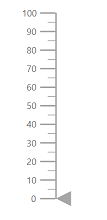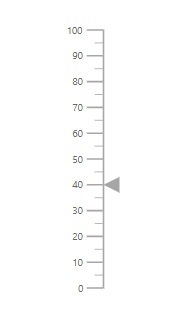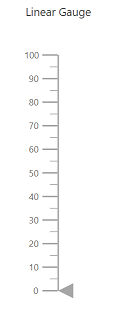Getting Started with Blazor LinearGauge Component (SfLinearGauge)
25 Sep 20258 minutes to read
The Blazor LinearGauge is an ideal component for visualizing numeric values in a linear scale with features like multiple axes, different orientations, and more.
This section briefly explains about how to include Blazor LinearGauge component in your Blazor WebAssembly App using Visual Studio and Visual Studio Code.
To get started quickly with Blazor LinearGauge component, check on the following video:
Prerequisites
Create a new Blazor App in Visual Studio
You can create a Blazor WebAssembly App using Visual Studio via Microsoft Templates or the Syncfusion® Blazor Extension.
Install Syncfusion® Blazor LinearGauge NuGet in the App
To add Blazor LinearGauge component in the app, open the NuGet package manager in Visual Studio (Tools → NuGet Package Manager → Manage NuGet Packages for Solution), search and install Syncfusion.Blazor.LinearGauge. Alternatively, you can utilize the following package manager command to achieve the same.
Install-Package Syncfusion.Blazor.LinearGauge -Version 31.2.12NOTE
Syncfusion® Blazor components are available in nuget.org. Refer to NuGet packages topic for available NuGet packages list with component details.
Prerequisites
Create a new Blazor App in Visual Studio Code
You can create a Blazor WebAssembly App using Visual Studio Code via Microsoft Templates or the Syncfusion® Blazor Extension.
Alternatively, you can create a WebAssembly application using the following command in the terminal(Ctrl+`).
dotnet new blazorwasm -o BlazorApp
cd BlazorAppInstall Syncfusion® Blazor LinearGauge and Themes NuGet in the App
- Press Ctrl+` to open the integrated terminal in Visual Studio Code.
- Ensure you’re in the project root directory where your
.csprojfile is located. - Run the following command to install a Syncfusion.Blazor.LinearGauge and Syncfusion.Blazor.Themes NuGet package and ensure all dependencies are installed.
dotnet add package Syncfusion.Blazor.LinearGauge -v 31.2.12
dotnet add package Syncfusion.Blazor.Themes -v 31.2.12
dotnet restoreNOTE
Syncfusion® Blazor components are available in nuget.org. Refer to NuGet packages topic for available NuGet packages list with component details.
Register Syncfusion® Blazor Service
Open ~/_Imports.razor file and import the Syncfusion.Blazor and Syncfusion.Blazor.LinearGauge namespace.
@using Syncfusion.Blazor
@using Syncfusion.Blazor.LinearGaugeNow, register the Syncfusion® Blazor Service in the ~/Program.cs file of your Blazor WebAssembly App.
using Microsoft.AspNetCore.Components.Web;
using Microsoft.AspNetCore.Components.WebAssembly.Hosting;
using Syncfusion.Blazor;
var builder = WebAssemblyHostBuilder.CreateDefault(args);
builder.RootComponents.Add<App>("#app");
builder.RootComponents.Add<HeadOutlet>("head::after");
builder.Services.AddScoped(sp => new HttpClient { BaseAddress = new Uri(builder.HostEnvironment.BaseAddress) });
builder.Services.AddSyncfusionBlazor();
await builder.Build().RunAsync();
....Add script resources
The script can be accessed from NuGet through Static Web Assets. Include the script reference in the <head> section of the ~/index.html file.
<head>
....
<script src="_content/Syncfusion.Blazor.Core/scripts/syncfusion-blazor.min.js" type="text/javascript"></script>
</head>NOTE
Check out the Adding Script Reference topic to learn different approaches for adding script references in your Blazor application.
Add Blazor LinearGauge component
Add the Syncfusion® Blazor LinearGauge component in the ~/Pages/Index.razor file.
<SfLinearGauge>
<LinearGaugeAxes>
<LinearGaugeAxis>
<LinearGaugePointers>
<LinearGaugePointer></LinearGaugePointer>
</LinearGaugePointers>
</LinearGaugeAxis>
</LinearGaugeAxes>
</SfLinearGauge>- Press Ctrl+F5 (Windows) or ⌘+F5 (macOS) to launch the application. This will render the Syncfusion® Blazor LinearGauge component in your default web browser.

Set pointer value
Pointers are used to indicate values on an axis. You can change the pointer value using the PointerValue property in the LinearGaugePointer.
NOTE
In LinearGauge, you can configure multiple axes. On each axis, you can add a pointer.
<SfLinearGauge>
<LinearGaugeAxes>
<LinearGaugeAxis>
<LinearGaugePointers>
<LinearGaugePointer PointerValue="40">
</LinearGaugePointer>
</LinearGaugePointers>
</LinearGaugeAxis>
</LinearGaugeAxes>
</SfLinearGauge>
Add a title for Blazor LinearGauge
The title can be added to the linear gauge to provide a piece of quick information to the users about the context of the rendered linear gauge. You can add the title to the linear gauge using Title property in SfLinearGauge.
<SfLinearGauge Title="Linear Gauge">
<LinearGaugeAxes>
<LinearGaugeAxis>
<LinearGaugePointers>
<LinearGaugePointer></LinearGaugePointer>
</LinearGaugePointers>
</LinearGaugeAxis>
</LinearGaugeAxes>
</SfLinearGauge>
Add ranges in the Blazor LinearGauge
The range is used to specify a group of scale values in the gauge. You can set the range start and end using Start and End properties in the LinearGaugeRange. You can add any number of ranges for an axis using LinearGaugeRange.
<SfLinearGauge>
<LinearGaugeAxes>
<LinearGaugeAxis Minimum="0" Maximum="200">
<LinearGaugeAxisLabelStyle Format="{value}°C"></LinearGaugeAxisLabelStyle>
<LinearGaugePointers>
<LinearGaugePointer PointerValue="140">
</LinearGaugePointer>
</LinearGaugePointers>
<LinearGaugeRanges>
<LinearGaugeRange Start="0" End="80" Color="#ff5985"></LinearGaugeRange>
<LinearGaugeRange Start="80" End="120" Color="#ffb133"></LinearGaugeRange>
<LinearGaugeRange Start="120" End="140" Color="#fcde0b"></LinearGaugeRange>
<LinearGaugeRange Start="140" End="200" Color="#27d5ff"></LinearGaugeRange>
</LinearGaugeRanges>
</LinearGaugeAxis>
</LinearGaugeAxes>
</SfLinearGauge>
NOTE